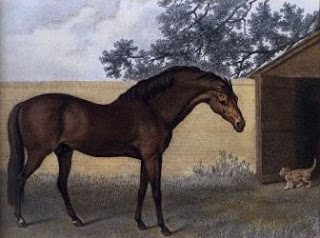On Tuesday, the 16th of September 1777, on Claverton Down, a 50 guinea sweepstakes was run between two horses over four miles. [1]
The winner was Mr Yeat's bay colt Patriot. The loser is described as Mr Coxe, a brown colt by Tatler Dam by White Nose.
Mr. Coxe has yet to be identified with certainty, but he was probably a member of the Hippisley Coxe family of Ston Easton.
We can, however, trace the origins of Mr. Coxe's colt.
Tatler, his sire, was a relatively undistinguished horse bred by the very important stallion Blank. Blank was bred by Frances, 2nd Earl of Godolphin, at his stud at Babraham in Cambridgeshire but sold as a six-year-old to Peregrin Bertie, the 3rd Duke of Ancaster and Kesteven for his stud at Grimsthorpe in Lancashire. The stallion Godolphin used bears his family name and is one of the three great founding oriental stallions of the thoroughbred horse. The colt's dam was, we are told, bred using the stallion White Nose. This stallion appears to have been bred either by Sir William Middleton or Thomas Panton in 1742; he never raced. He was, however, remarkably successful at stud and is considered among the top ten of the Godolphin Arabian's sons.
The Godolphin Arabian, initially known as Sham or Shami, was foaled in Yemen in 1724 (from Jilfan blood). A brown colt with a bit of white on his off-hind heel, he stood 14.3 hands high.
He was exported via Syria to Tunis as one of four horses to be presented by the Bey of Tunis to the King of France. In France, he was acquired by an Englishman, Edward Coke, who sent his purchase to his estate at Longford Hall in Derbyshire.
When Coke died in August 1733, aged only 32, he bequeathed his bloodstock to Roger Williams, proprietor of the St James's Coffee House in London, who also acted as a bloodstock agent. Williams then sold the Arabian to Francis, 2nd Earl of Godolphin.
1. Bath Chronicle

